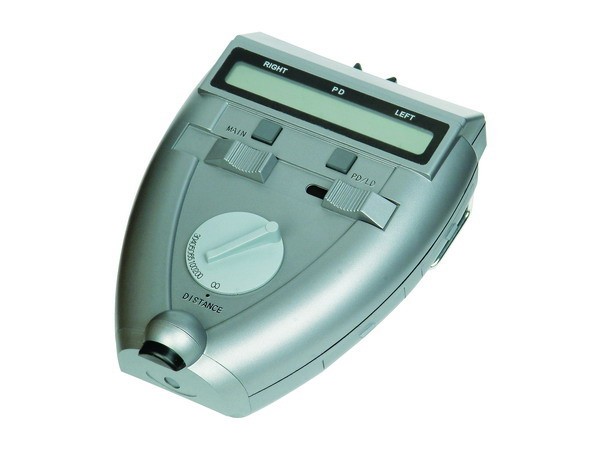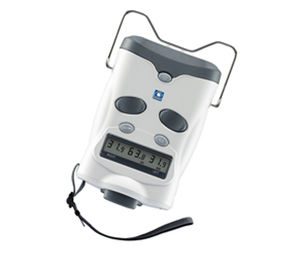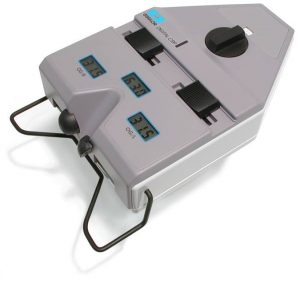Categories
Digital pupillometer

We know our eyes are the windows to the soul, but they are also windows to our general state of health, and while we might think a digital pupilometer is used only by an optometrist when we have our eyes tested, it is also used by healthcare practitioners and specialists.
The pupil is the round black circle in the middle of the colored part of the eye, the iris, and they are literally windows, or holes, through which light passes to the light-sensitive area in the back part of the eye, otherwise called the retina. The size of our pupils can tell someone who knows what to look for a lot of information about our health, and while some dilation is normal, unequal sized pupils are usually the sign of an illness or disease. To assess how our pupils dilate, and how quickly they do so, your GP or specialist will use a digital pupilometer.
Contents
- How Our Pupil Works
- The Difference between a Distance Measuring Digital Pupilometer and a Pupil Response Digital Pupilometer
- What Your Pupils Reveal About Your Health
- What Diseases Could Be Diagnosed
- How is Pupil Size Measured
- Measuring the Distance between Pupils
- Technology and Digital Pupilometers
- Easy-to-follow Steps to Using a Digital Pupilometer
- Conclusion
How Our Pupil Works
The pupil works in much the same way as a camera aperture does, controlling how much or how little light gets in. To manage this our pupil becomes larger, or dilates, and constricts, or becomes smaller. The muscles in our iris respond accordingly to outside stimuli, controlling how much light reaches the retina; in dim light the pupil dilates to allow more light in, allowing our vision to improve. A normal pupil measures between 2.0 and 5.0mm depending on the lighting. Our pupil size is typically larger when we are young and gradually diminishes with age.

Your GP or specialist will use a digital pupilometer to take a closer look at the shape and size of your pupil in both bright and dim light and he, or she, will also take into consideration the quality of, and the speed in which your pupil responds to the stimuli.
The Difference between a Distance Measuring Digital Pupilometer and a Pupil Response Digital Pupilometer
Both of these are used by an eye doctor, whereas a doctor uses the pupil response pupilometer to check on various health conditions. This particular one monitors your pupil’s response to light and other visual stimulants. Some GPs and eye doctors do use a penlight for this as h=they believe it does the same job.
The more common pupilometer is the one to measure distance, which we will look at in more detail later on.
What Your Pupils Reveal About Your Health
It goes without saying when you visit your optometrist they are testing your vision, seeing if there are any eye-related issues and if you need any kind of corrective treatment. However should they notice anisocoria, they will more than likely refer you to a doctor.
Anisocoria is a condition where your pupil sizes are unequal. Twenty percent of the population have what is considered normal anisocoria and it doesn’t signal anything abnormal, there are a few cases when unequal pupil sizes are a symptom of an underlying condition or disease.

The reason the pupil can tell us so much is because it is controlled by a very long nerve pathway in our bodies: it starts in the brain, travels down to the spinal cord, up and over the lung, then under the subclavian artery, back up the neck and through the various extensions of the brain, passing the optic nerve and then to the pupil. Any problems along this pathway could affect the nerve, which would cause a change in the pupillary reaction.
What Diseases Could Be Diagnosed
Should you notice a change in your pupils be sure to make an appointment with your healthcare specialist. Our list is comprehensive and includes mild to serious problems and even life-threating ones.
- Glaucoma: Often a mid-dilated pupil can point to glaucoma. If left untreated it can lead irreversible loss of vision.
- Certain medications: certain medicines can cause dilated pupils
- An aneurysm: if an aneurysm is pushing on certain blood vessels in the brain it can cause a dilated pupil.
- Cluster headaches: if you suffer from cluster headaches they can also cause a constricted pupil.
- Head trauma: any types of trauma to the head including concussion can result in unequal sized pupils.
- Brain tumor: in the case of a tumor being close to the origin of pupillary nerve fibers your pupils may be affected.
- Recreational drugs: some recreational drugs can cause pupils to either dilate or constrict.
- Cancer of the lung: lung cancer affecting the top of the lung, where the nerve pathway runs, can affect the pupillary nerve fibers.
- A Stroke: sometimes a stroke can cause changes in the size of the pupil.
- Syphilis: syphilis causes what is known as an Argyll-Robertson pupil. In this case, the pupils are small misshapen and unequal. They constrict if you focus on things close by but they do not react to light in a normal way.
It is safe to say our pupils are indeed windows to our health, but how are they measured?
How is Pupil Size Measured
There are a few ways a doctor can determine and maintain our eyes’ health, including using an eye chart, retinoscopes and lensometers as well as a pupilometer. An optometrist also uses a pupilometer to check the condition of your eyes. There are two types: the one measures the distance between your pupils and the one that can test the responsiveness of the pupil.
Measuring the Distance between Pupils
Optometrists use a pupillary distance digital pupilometer to measure the distance between pupils and is usually done for the fitting of spectacles. The exact distance is measured between the center of the pupils, and it records it in millimeters.
In the case of an eye test, the pupilometer works by looking at the distance between the bridge of your nose, where glasses would sit, and the middle of each of your pupils. If the measurement isn’t done correctly and the measurements are wrong the glasses won’t fit well, which will cause discomfort as well as headaches and eyestrain. Most eye doctors use a digital pupilometer, however, there are a few that still use a ruler and then use the pupilometer to confirm the measurements.
Technology and Digital Pupilometers
Today there are smartphone apps and programs that measure pupillary distance. They are sometimes more of a marketing gimmick but they do actually work, and a lot of spectacle retailers use these to size glasses. The app does require a camera on your smartphone in order for it to work.
To recap, the distance pupilometer is used when fitting patients for new specs. They measure specific measurements for normal, or standard glasses, and give different measurements for bifocals and even trifocals.
Easy-to-follow Steps to Using a Digital Pupilometer
Besides general health practitioners and optometrists, there are other people who use a digital pupilometer. Anyone selling spectacles or contacts will make use of it to measure the distance between the pupils. Essentially without this piece of equipment, spectacles and contact lenses will not fit correctly.
While it might look like an intimidating apparatus, using the pupilometer is fairly simple. Follow our easy steps:
- Ensure the Patient is in the Correct Position
As obvious as it might sound it is important to make sure the patient is sitting in the correct position. They must be seated, with their back straight and their head facing forward. To use the pupilometer you must be seated at an equal height to the patient. Having an adjustable chair will ensure you are able to do this comfortably.
- Placing the Pupilometer in Position
If you look at the digital pupilometer you should notice a shape that resembles a triangle, with one a lot wider than the other. Still looking at it, you will notice a side with either buttons or numbers; to make sure you are using the pupilometer correctly this side, with the buttons or numbers, must always face toward the ceiling. Place the widest side directly in front of the patient and then place the nose pads onto their nose. Even though you will be assisting with the process, the patient must hold it in place, as if they were holding binoculars. At this point, they will be looking straight ahead, not moving, and focusing on the bright light in front of them.
- Setting the Pupilometer Correctly
You will need to adjust the digital pupilometer’s settings to infinity, using the ‘distance wheel’, which is either on top or on the side. There should either be a numeric abbreviation or the word ‘infinity’. If you can’t see either, then look for this symbol ∞. The best way to describe it is it looks like a number eight lying on its side.
- Measuring Pupil Distance at Infinity
While the patient looks straight and the digital pupilometer is set correctly, the patient’s eyes adjust so that both pupils are concentrated on the light. Slowly you will need to adjust the settings until the pupils are lined up and you can see the reading clearly. You will occasionally notice the pupils are not straight at ‘infinity’ and in these situations, the patient might have a condition called hypermetropia, otherwise called long or far-sightedness.
- Resetting the Digital Pupilometer at Closer Distances
Once you have measured the distance you need to look at the closer distance, which can be 35, 40 or 45 – these are the most common settings. When measuring the near or close pupil distance the patient must still be looking ahead while focusing on the light they can see in the distance. Agan their pupils will adjust accordingly, In the case of someone who may be short-sighted, their PD will be smaller.
- Measuring and Recording Distance for Eyeglasses
A digital pupilometer is used to determine what size the frames should be. Using the easy-to-follow steps above you will be able to assess both the measurements. If you, as the eye doctor has gotten these correct, your patient will be able to have their prescription specs fitted and adjusted to fit their face shape, their eyes and be able to assist them with their long- or short-sightedness.
To recap, the pupil response digital pupilometer is used to measure how the pupils respond to light. Unlike the distance pupilometer, these are monocular and test each eye one at a time. Pupil response pupilometers are used by optometrists and doctors to measure the responsiveness of the pupil, which is a good indicator of a patient’s overall health as well as the condition of their eyes. As mentioned, the way in which a pupil responds to light can be an indicator of certain illnesses or underlying health conditions.
Pupil response digital pupilometers can also be used before, and after surgery to make sure the entire area of the eye has been corrected.
Conclusion
New research has shown that a digital pupilometer can also tell us more about a patient’s brain function. For more than a hundred years health practitioners have checked the pupils of a patient to determine their overall health and brain function. We have looked at how a specialist can identify diseases or other conditions using a pupil response digital pupilometer, and an optometrist uses a distance pupilometer to ensure eyeglasses fit correctly, but the way a pupil reacts to light can also give an indication of how our brain is working. Using words like “brisk”, “non-reactive” and “sluggish. Although a simple test it is an essential one that can give more insight to a patient’s condition.
It goes without saying that using this method holds a high risk of human error. There are a number of factors that can give an incorrect result, like the brightness of the penlight. Also because it is subjective, different people will have different perceptions and opinions of what the pupil looks like. One nurse might think everything looks normal, while another nurse on a different shift but refer to the same pupil response as sluggish. With the naked eye and a flashlight, the slightest changes in the pupil’s response time might be missed, which could be the difference between life and death, which is why the digital pupilometer is now being used to assist in this area too.



